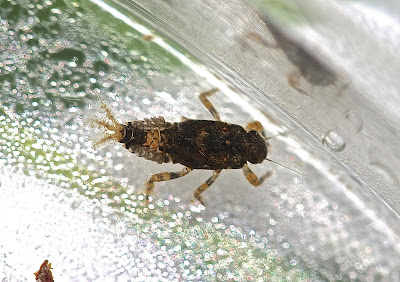I found this beautiful "white nymph" (the term used by fly fishermen) in the North Fork of the Moormans just a couple of hours ago. This is a recently molted common stonefly; it appears to be an
Acroneuria abnormis (we can't be sure of ID until the skin has darkened.) This was a large nymph -- I would guess it was ~ 25 mm -- which would make it a female. According to Steven Beaty ("The Ephemeroptera of North Carolina," p. 14), mature male
A. abnormis nymphs are 15-20 mm in length; females are 25-30. (This one isn't "mature," but note how the rear edge of the wing pads has started forming an arc.)
Stonefly nymphs "molt" -- i.e. shed their skins (cuticle, integument) -- 12-36 times from the first to the final instar, the number varies by species (Barbara Peckarsky,
Freshwater Macroinvertebrates, p. 58). Since
A. abnormis is semivoltine (2 year life cycle), the number of molts is probably high. Still, I've never seen "white nymphs" that are not in their season of hatching (this nymph will clearly be hatching next spring).
When a nymph sheds its skin it is creamy white, and the new skin is soft. But, the new skin darkens and hardens in
a matter of hours. I.e. this nymph by now probably looks something like this (this one was also in the North Fork this morning):
That being the case, I always feel lucky to find a "white nymph": you have to be lifting the rocks at just the right moment. But I've seen a fair number of these -- then, too, I spend a lot of time in the fall and the winter lifting up rocks and sifting through leaf packs!
These nymphs from last year were also "freshly molted."
1. Peltoperlid, genus
Tallaperla, found on 12/3 of last year followed, by one that's fully colored found the same day.
2. A flatheaded mayfly,
Stenacron interpunctatum found on 5/14 of last year, followed by a mature one found the next month on 6/16. (Note the similar gills.)
Mayflies can molt from 12-45 times, by the way, according to Barbara Peckarsky (
Freshwater Macroinvertebrates, p. 22).
_______________
All in all, I saw very little at the North Fork today, other than the stoneflies that were in leaf packs in pretty good numbers. I saw
Acroneuria abnormis and
Acroneuria carolinensis, both of our
Acroneuria species (see the entry posted on 9/20): I also saw a fair number of Giant stoneflies. These appeared to be
Pteronarcys scotti, the species we normally see in Sugar Hollow streams.
A. carolinensis
Pteronarcys scotti
_______________
And a final look at our freshly molted
A. abnormis nymph.

























































